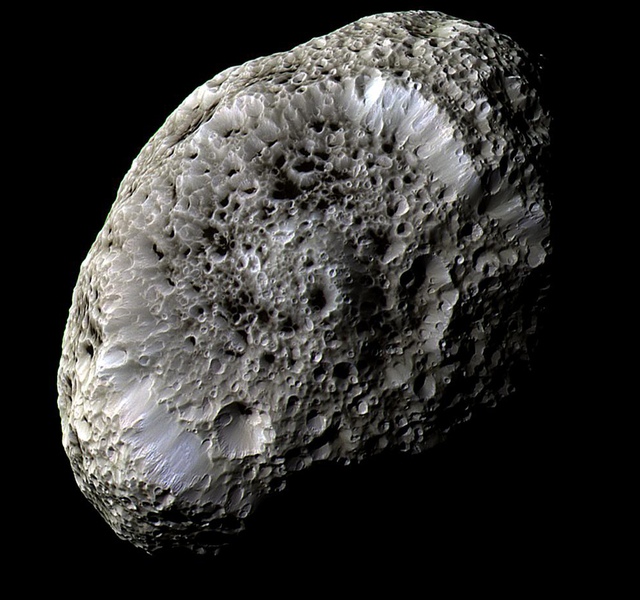Cassini image of a Saturnian eclipse. Image: NASA/JPL/SSI
Ever since it first went into orbit around Saturn in July 2004, NASA's Cassini spacecraft has racked countless discoveries about the gas giant and its spectacular set of rings, moons, and satellites. From delivering the ESA-built Huygens lander to Saturn's moon Titan to recording the fallout of Saturn's Great White Spot storm on the planet itself, the Cassini mission has been a nonstop scientific goldmine for planetary scientists.Alas, all good things must come to an end, and Cassini's days are now numbered. In September 2017, the spacecraft will peace out after its long, illustrious career and tumble into the depths of the gas giant it has orbited over a decade. It is already in the process of making the rounds around Saturn's diverse moons—seven of which it discovered—to offer its final goodbyes.On Sunday, for example, Cassini will visit the bizarre moon Hyperion for the last time. Mission leads can't predict exactly what side of the moon will be exposed to the orbiter, because Hyperion's axis is uniquely wobbly and off-kilter. In fact, it is the the only moon in the solar system that rotates chaotically, the only natural satellite that is not tidally locked to its host planet. On top of that, Hyperion's geological properties are very weird. Its surface is sponge-like and heavily cratered, and its potato-like shape suggests it may be leftover debris from a massive collision. As planetary geologist Jeff Moore put it: "Hyperion looks like it had the crap smashed out of it."The Cassini team hopes to luck out with a new angle on this fascinating moon as it flies by this Sunday, but even if it doesn't, the orbiter has a lot more to look forward to in its upcoming golden years. Starting in late 2016, Cassini will begin its so-called "Grand Finale" mission, in which it will sample alien geysers, dip between the Saturnian rings, and take up-close pictures of the planet itself before diving into its gaseous exterior."We chose a name for this mission phase that would reflect the exciting journey ahead while acknowledging that it's a big finish for what has been a truly great show," said Cassini project manager Earl Maize in a NASA statement.Indeed, though it will be sad to see this incredibly successful mission end, it looks as if Cassini's last two years are shaping up to be among its best.
On top of that, Hyperion's geological properties are very weird. Its surface is sponge-like and heavily cratered, and its potato-like shape suggests it may be leftover debris from a massive collision. As planetary geologist Jeff Moore put it: "Hyperion looks like it had the crap smashed out of it."The Cassini team hopes to luck out with a new angle on this fascinating moon as it flies by this Sunday, but even if it doesn't, the orbiter has a lot more to look forward to in its upcoming golden years. Starting in late 2016, Cassini will begin its so-called "Grand Finale" mission, in which it will sample alien geysers, dip between the Saturnian rings, and take up-close pictures of the planet itself before diving into its gaseous exterior."We chose a name for this mission phase that would reflect the exciting journey ahead while acknowledging that it's a big finish for what has been a truly great show," said Cassini project manager Earl Maize in a NASA statement.Indeed, though it will be sad to see this incredibly successful mission end, it looks as if Cassini's last two years are shaping up to be among its best.
Advertisement
